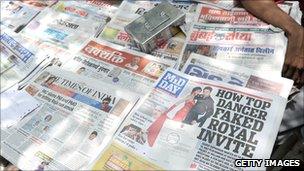Newspapers : Why India’s newspaper industry is booming
- Published

As the print deadline approaches, there is a sense of urgency in the air. It is late evening at the offices of the Mylapore Times and in a few more hours the first proofs of the paper need to be ready.
The newspaper has a weekly circulation of more than four thousand copies, but its offices are modest.
One small room with bright blue walls houses the production team which comprises no fewer than seven people at any given time.
The adjacent room, piled high with old editions, is the reception area hosting a steady stream of local businessmen and women here to take out advertisements.
Advertisements are the lifeblood of this local newspaper and its pages are filled with classified postings for jobs and services.
Revenue from these is growing, and keeps the paper functioning, says its editor Vincent D'Souza.
This is in stark contrast to that of many local newspapers in the US and the UK, which have been forced to shut down or scale back because of diminishing advertising income.
"The story in India is quite different because local businesses are growing because of globalisation and opening up of the markets.
"I think people are becoming more ambitious and there are lots more entrepreneurs in the country," he says.
Increased revenue
Despite the hold the television industry has on the country, it is the print press which is attracting more advertisers, making up 47% of the overall share.
In the past year alone, advertising spend for print media was worth $2.86bn (£1.74bn).
A recent industry analysis from KPMG and the Federation of Indian Chambers of Commerce and Industry (FICCI) suggested that the value of the Indian newspaper industry has grown by two-thirds in the past six years.
In 2005, the total industry was worth $2.64bn dollars. This rose to $4.37bn in 2010.
It is predicted to continue to rise at an annual rate of 10% between 2011-2014.
The localisation of content and the introduction of specific pullouts, such as wedding supplements and womens' sections, is one reason why newspapers continue to pull in advertisers, says Mr D'Souza.
More than 107 million copies of newspapers were circulated daily across India in 2009, according to the World Association of Newspapers, and it's estimated that one in every five daily newspapers in the world is published in the country.
Diverse readers
Increased literacy is one reason for the rise in newspaper readership in India - not just in English language titles but in regional languages.
Almost one-third of India's 579 million literate population is said to read a newspaper now, according to KPMG analysis.
Across India there are hundreds of titles in regional dialects. The country's two top-selling newspapers are Dainik Jagran and Dainik Bhaskar, according to the Media Research Users Council. Both are published in Hindi and continue to attract readers and revenue.
All this is making the existing newspaper market much more competitive.
Editorial staff at the Hindu, Chennai's oldest surviving newspaper, say they've had to adapt to survive.
The paper had a "virtual monopoly" in the English language newspaper market in Chennai, but in recent years other national newspapers such as the Times of India have started editions, says Mukund Padmanabhan, associate editor of The Hindu.
The paper now has a number of regional editions, which contain national content alongside pages of localised news relevant to the distribution area.
"We're having to expand and open more editions," he says. "This is a large country so you need to have multiple printing centres. More and more newspapers are reaching out to places where they haven't before."
Another reason for increased readership is the low cost of buying a newspaper, says Mr Padmanabhan.
"Pricing is at about a tenth of the price of a newspaper in America or in the UK so it's possible for an upper middle-class family to buy two or three newspapers a day."
Internet factor
While many newspaper markets have been hit by the growth of online journalism the outlook for Indian print media remains buoyant.
The figures on the numbers of newspapers in India vary greatly, but it's believed there are thousands rather than hundreds of in them the country, with many more editions being added all the time.
One of the key reasons is the low penetration of internet outside large urban centres.
"India is considered among those developing countries that will last see the wrath of digital penetration because Internet penetration is still nascent and consumer migration has not yet happened," says KPMG.
In the West, the rise of the internet has been a driving factor in the demise of many print editions.
Paul Gillin, who runs the website newspaperdeathwatch.org, says by one count he saw more than 200 weeklies close in the US 2009 alone.
While they are growing considerably and raking in the profits of India's rapid expansion, the newspapers in the country are well aware of the imminent threat posed by the web.
"Internet penetration is still relatively low but that will soon change," says Mr Padmanabhan.
"Every newspaper realises there's lots more competition than there was before."
- Published31 July 2011
- Published27 July 2011
- Published27 June 2011